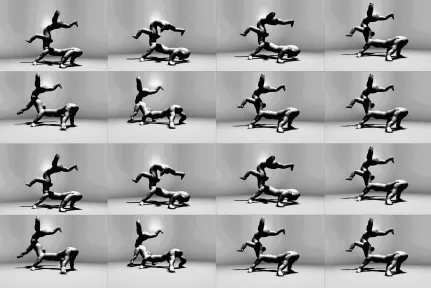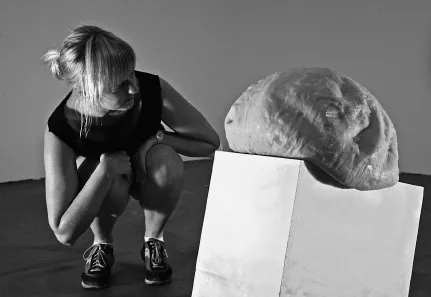
An Introduction to Electronic Art Through the Teaching of Jacques Lacan
Strangest Thing
- 184 pages
- English
- ePUB (mobile friendly)
- Available on iOS & Android
An Introduction to Electronic Art Through the Teaching of Jacques Lacan
Strangest Thing
About this book
Electronic art offers endless opportunities for reflection and interpretation. Works can be interactive or entirely autonomous and the viewer's perception and reaction to them may be challenged by constantly transforming images. Whether the transformations are a product of the appearances or actions of a viewer in an installation space, or a product of a self-contained computer program, is a source of constant fascination. Some viewers may feel strange or unnerved by a work, while others may feel welcoming, humorous, and playful emotions. The art may also provoke a critical response to social, aesthetic, and political aspects of early twenty-first-century life. This book approaches electronic art through the teachings of Jacques Lacan, whose return to Freud has exerted a powerful and wide-ranging influence on psychoanalysis and critical theory in the twentieth century.
David Bard-Schwarz draws on his experience with Lacanian psychoanalysis, music, and interactive and traditional arts in order to address aspects of the works the viewer may find difficult to understand. Dividing his approach over four thematic chapters—Bodies, Voices, Eyes, and Signifiers—Bard-Schwarz explores the links between works of new media and psychoanalysis (how we process what we see, hear, touch, imagine, and remember).
This is a fascinating book for new media artists and critics, museum curators, psychologists, students in the fine arts, and those who are interested in digital technology and contemporary culture.
Frequently asked questions
- Essential is ideal for learners and professionals who enjoy exploring a wide range of subjects. Access the Essential Library with 800,000+ trusted titles and best-sellers across business, personal growth, and the humanities. Includes unlimited reading time and Standard Read Aloud voice.
- Complete: Perfect for advanced learners and researchers needing full, unrestricted access. Unlock 1.4M+ books across hundreds of subjects, including academic and specialized titles. The Complete Plan also includes advanced features like Premium Read Aloud and Research Assistant.
Please note we cannot support devices running on iOS 13 and Android 7 or earlier. Learn more about using the app.
Information
BODIES
Abjection

One side of a machinic assemblage faces the strata, which doubtless make it a kind of organism, or signifying totality, or determination attributable to a subject; it also has a side facing a body without organs, which is continually dismantling the organism, causing signifying particles or pure intensities to pass or circulate and attributing to itself subjects that it leaves with nothing more than a name as the trace of an intensity.(Deleuze and Guattari 1987: 4, original emphasis)
God is a lobster, or a double pincer, a double bind … The first articulation chooses or deducts, from unstable particle flows, metastable molecular or quasi-molecular units (substances) upon which it imposes a statistical order of connections and successions (forms). The second articulation establishes functional, compact, stable structures (forms), and constructs the molar compounds in which these structures are simultaneously actualized (substances).(Deleuze and Guattari 1987: 40–41)
The proof that there is isomorphism is that you can always get from one form on the organic stratum to another, however different they may be, by means of “folding.” To go from the Vertebrate to the Cephalopod, bring the two sides of the Vertebrate's backbone together, bend its head down to its feet and its pelvis up to the nape of its neck.(Deleuze and Guattari 1987: 46)
The very delimitation of the “erogenous zone” that the drive isolates from the function's metabolism … is the result of a cut that takes advantage of the anatomical characteristic of a margin or border: the lips, “the enclosure of the teeth,” the rim of the anus, the penile groove, the vagina, and slit formed by the eyelids, not to mention the hollow of the ear … Respiratory erogeneity has been little studied, but it is obviously through spasms that it comes into play.(Lacan 2006: 692)

The body's inside … shows up in order to compensate for the collapse of the border between inside and outside. It is as if the skin, a fragile container, no longer guaranteed the integrity of one's “own and clean self” but, scraped or transparent, invisible or taut, gave way before the dejection of its contents. Urine, blood, sperm, excrement then show up in order to reassure a subject that is lacking its “own clean self.” The abjection of those flows from within suddenly become the sole “object” of sexual desires—a true “ab-ject” where man, frightened, crosses over the horrors of maternal bowels and, in an immersion that enables him to avoid coming face to face with an other, spares himself the risk of castration.(Kristeva 1982: 53)
[t]he abject confronts us … and this time within our personal archaeology, with our earliest attempts to release the hold of the maternal entity even before ex-isting outside of her thanks to the autonomy of language. It is a violent, clumsy breaking away, with the constant risk of falling back under the sway of a power as securing as it is stifling.(Kristeva 1982: 13, original emphasis)
[T]he interest the subject takes in his own split is bound up with that which determines it—namely a privileged object, which has emerged from some primal separation, from some self-mutilation induced by the very approach of the real, whose name in our algebra, is the objet [petit] a.(Lacan 1981: 83, original emphasis)7
Table of contents
- Cover
- Half Title
- Title Page
- Copyright Page
- Dedication
- Table of Contents
- Acknowledgments
- Introduction
- 1 Bodies
- 2 Voices
- 3 Eyes: ?
- 4 Signifiers
- Bibliography
- Index